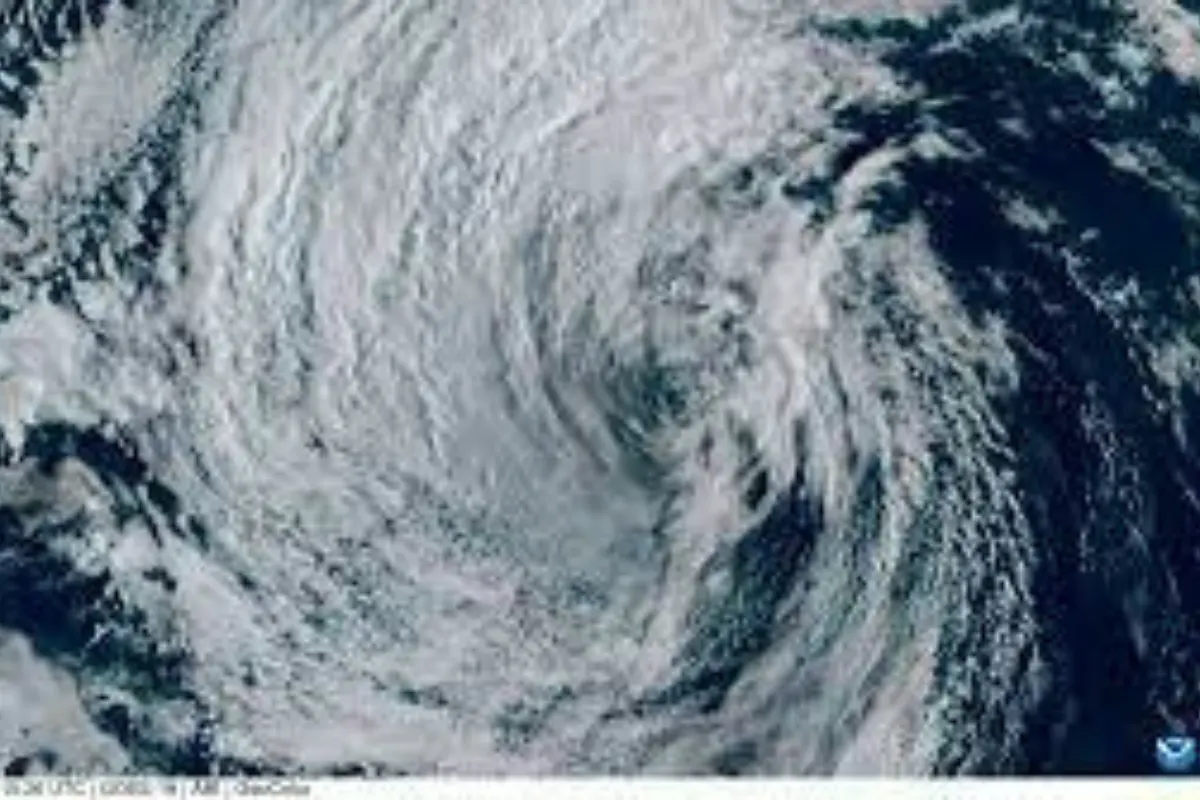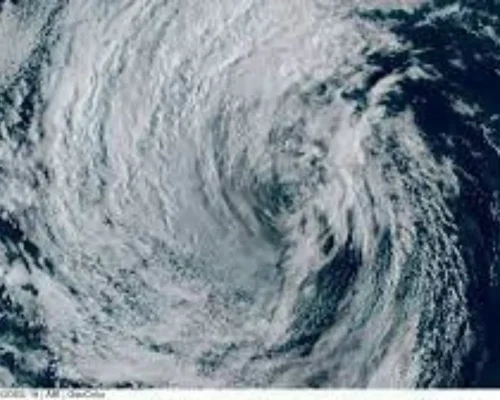Imagine: Alaska Typhoon autumn nights, which are as dark as ink, see a Pacific hurricane that goes against the rules, one that used to be a typhoon far away, changing into a howling mad animal that hits with the strength of a thousand landslides, weak villages.
The waves are rising as if they were spirits seeking revenge; they are 15 feet high, eating whole houses, throwing older adults and kids onto the roofs so they can escape as the whirling disorder swallows their lives.
October 12-13, 2025, are the dates, and Typhoon Halong’s effects completely changed the map of Western Alaska, leaving one dead, two people missing, and more than 1,400 people displaced by a flood that covered the area.
For ordinary people in the U.S., living in Seattle or Florida, it is not a story far from them, but rather a very close and authentic experience—an alarm signaling the advance of climate change in areas near to them.
The Coast Guard helicopters flying through the spray and the city of Nome, which is preparing for the next blow, are where the Alaska typhoon 2025 story poses its stunning question and offers people a glimpse of the untamed nature and its raw bravery. Will the delta’s indomitable Yup’ik rise again? Strap in —we’re plunging into Halong’s wild path, the heart-wrenching human toll, and the urgent rebuild that could redefine resilience at America’s last wild edge.
From Pacific Predator to Arctic Invader: The Birth and Brutal Path of Typhoon Halong
On October 5, Typhoon Halong didn’t start to be heard or felt; instead, it came with a mighty force to the northern Philippine Sea as a Category 4 giant, making the sea with its 140 mph winds and waves that reached Japan’s coast, but played with it as a cat with a mouse. After that, on October 10, it was no longer a tropical storm but had reached the Aleutians as an extratropical cyclone, changing its furious complaints for a colder, more intense one, where the strongest winds of 100 mph could easily snap spruce trees in half. The NOAA forecasters were terrified to see the unusually warm Pacific waters that gave Halong the energy to travel far into the north, the melting of the Arctic ice acting as a lubricant for the rails this uninvited guest would take.
Halong’s core pivoted east, defying models that eyed St. Lawrence Island or Diomede, sparing Nome’s initial fury but unleashing hell on the Yukon-Kuskokwim Delta. Sunday night, October 12: The eye wall gouged the shore close to Kipnuk, a frenzy which elevated the Kuskokwim River 6.6 feet over high tide, a new record that made gravel airstrips turn into gravel soup. Kotlik saw 78 mph blasts that cut power lines to pieces and threw fragments like shrapnel; Bethel’s beach area turned into a derby of destruction, a small ship running against bridges while 10-foot waves were rolling.
By Monday, October 13, Halong’s heart churned into the Bering Sea, downgraded but dragging 50 mph gales and secondary floods toward the Chukchi. Utqiagvik (Barrow) braced for 15-foot waves and light snow squalls, a freak October mix of rain and rime, as the system flirts with the Arctic coast by midweek. This wasn’t a tidy typhoon; it was a hybrid horror, born of El Niño’s hangover and amplified by 3°C warmer seas, per climatologist Rick Thoman. For Alaskans, it’s déjà vu: 2023’s Merbok flooded 20 villages; now Halong ups the ante, a storm-surge symphony on permafrost’s shaky stage.
What hooks you here? Halong’s rogue reroute spared one coast to savage another, a meteorological game of Russian roulette that left rescuers racing the tide. As it ghosts north, eyes on erosion’s edge, could this be the push for Newtok’s complete exodus?
Villages Vanished in the Vortex: The Human Heartbreak in the Yukon-Kuskokwim Delta
Halong’s sole, a picture of death traced in mud and memory, destroyed the delta’s mosaic of 49 Yup’ik and Inupiaq or villages, small lights in the middle of the vast tundra. Ground zero was Kipnuk, a 700-person fishing village: Waters rose to 8 feet, detaching 20 houses that drifted like corks before they were stuck miles from shore, soaked with relatives’ antiques.
Rooftop evacuations totaling 16, children protected by mothers among falling rafters, Newtok’s gym-turned-shelter where 172 lives shared MREs and murmured prayers, were full.
Kwigillingok, 20 miles south, carved deeper scars: A woman’s body recovered Monday evening, swept from her floating abode; two elders vanish in the murk, their canoes adrift like ghosts. Eighteen rescues there, Coast Guard Jayhawks winching families from debris rafts, left 200 huddled in a schoolhouse, generators humming against the chill. Napakiak’s airstrip drowned in brine, stranding insulin runs; Kotlik’s 78 mph winds felled towers, blacking out 90% and hurling roofs like frisbees, injuring five with gashes and breaks.
Bethel, the reluctant hub, dodged annihilation but not anarchy: Kuskokwim waves pulverized docks, a rogue barge’s bridge bash sparking 300 evacuations and riverfront rubble. Across the delta, 1,400 displaced, many elders reliant on subsistence seals and salmon now poisoned by diesel sheens from 50+ toppled tanks. Fuel for winter’s bite? Compromised. Power? Flickering phantoms. Yet amid the wreckage, stories sting: A Kipnuk fisherman lashing his skiff to a tree, saving his nets, and his neighbor’s life.
This isn’t stats; it’s souls, families whose freezers floated away, erasing months of berry-picking bounty. Halong didn’t just flood; it fractured lifelines in America’s remotest heart.
Delta’s Devastated Dots
- Kipnuk (Pop. 700): 20 homes afloat; 16 rooftop rescues; school, a shopping sanctuary.
- Kwigillingok (Pop. 600): One death, two missing; 18 airlifts from midnight maelstrom.
- Kotlik (Pop. 600): Winds warp roofs; 80% dark, five injured by airborne havoc.
- Napakiak (Pop. 350): Airstrip awash; barge blockades aid.
- Bethel (Pop. 6,000): Waterfront wreckage; 300 fled, bridge battered.
These specks on satellites are searing human sagas.
Lifelines from the Sky Rescue Realities in Isolation’s Grip
As dawn clawed through the clouds on October 13, Alaska’s cavalry converged: Gov. Mike Dunleavy’s National Guard unleashed 150 troops and six Black Hawks from Elmendorf, logging 51 saves by dusk, winches whirring over wave-tossed wreckage. U.S. Coast Guard’s District 17, HC-130s from Kodiak, dropped rings to swimmers in Kwigillingok’s ink, their spotlights carving hope from horror. “Folks floated on debris in darkness,” Capt. Culpepper briefed the Anchorage press, voice laced with grit.
Troopers from Soldotna quarterbacked, ferrying hypothermic huddles to Bethel’s bursting hospital, cuts from glass grenades, chills chasing the chill. No roads? No problem, every pallet parachutes in, MREs mingling with village moose stew in crammed gyms. FEMA loomed in standby mode, Acting Director David Richardson on speed dial with Sen. Dan Sullivan, and tribal councils clamoring for declarations.
Locals led the charge: Kipnuk’s public safety officer, rifle-ready, herded swimmers to high ground; Kwigillingok elders jury-rigged CBs for many days when cells croaked. By October 14, shelters had stabilized at 1,400, but isolation’s bite lingers, flights are grounded, and boats are battered. Oil slicks? A creeping crisis; 50 fuel farms teeter, their breach a beluga’s bane.
For Lower 48 kin, it’s logistics litmus: Our northern neighbors’ pluck, mirroring Harvey’s Houston hugs, proves community trumps calamity, but remoteness redoubles the rally.
Rescue’s Relentless Roll Call
- National Guard: 150 boots, six helos; 30+ medevacs to safety.
- Coast Guard: 21 aerial saves; pollution patrols probing sheens.
- Village Vanguard: Locals lashing lines, boiling meat for broth.
- FEMA Frontier: Federal firepower fueled for Dunleavy’s decree.
In peril’s pulse, these pulses save worlds.
Warming’s Wicked Whiplash Climate’s Role in Halong’s Rampage
Halong’s Arctic detour? No freak; it’s the fingerprint of a fevered planet. Western Alaska warms thrice global clip, permafrost pummels, coasts chew 20 feet yearly, storms surge savage as ice-free seas sip summer heat. Rep. Mary Peltola, delta-born Yup’ik, nailed it on October 13: “Warming disrupts Y-K lives these 25 years,” Newtok’s $100 million move the first domino in a village exodus chain.
Dunleavy hedges, “Storms stacked these years”, but NOAA bites back: 30% fiercer Pacific typhoons veer poleward, Arctic amplification arming “bomb cyclones” with tropical teeth. Merbok ’23 flooded 20 spots; Bavi ’24 brushed bolder; Halong? Harbinger, its surge is a symptom of 3°C seas steering south swells north. Subsistence snaps: Salmon streams silt, seal hunts sink, food flights fetch $1,000 per load.
Nationwide wake-up: Gulf gales grind harder, Cali blazes blaze eternal, Halong’s howl echoes Harvey’s, a call for $1 billion resilience bucks. As it chills into Chukchi snow, midweek’s mix mocks mercy, wetter winters, wilder waves.
Rebirth from the Rubble: The Road to Arctic Renewal
Waters wane, pumps pulse 24/7 October 14, but the ledger lengthens: $50 million mangled, dozens of homes history, power phantoms in Kotlik. Dunleavy drills for federal funds; Coast Guard charts spills; villages vow: Kipnuk elders evoke ’64’s quake grit, tougher than tides.
Long haul? Berms beefed, homes hoisted, climate codex, Newtok’s template for 10 more outposts. Spirit? Unbreakable: Fishers forging forward, kids in shelters sketching salmon returns. For us 49-staters, Alaska typhoon 2025 is kin’s clarion, donate Red Cross red, lobby green grids. Storms ebb, but scars school: The frontier forges fiercer.
As Halong haunts the horizon, one whisper lingers: In chaos’s churn, courage carves calm. What’s our next move? The north nods, resilient, ready.





